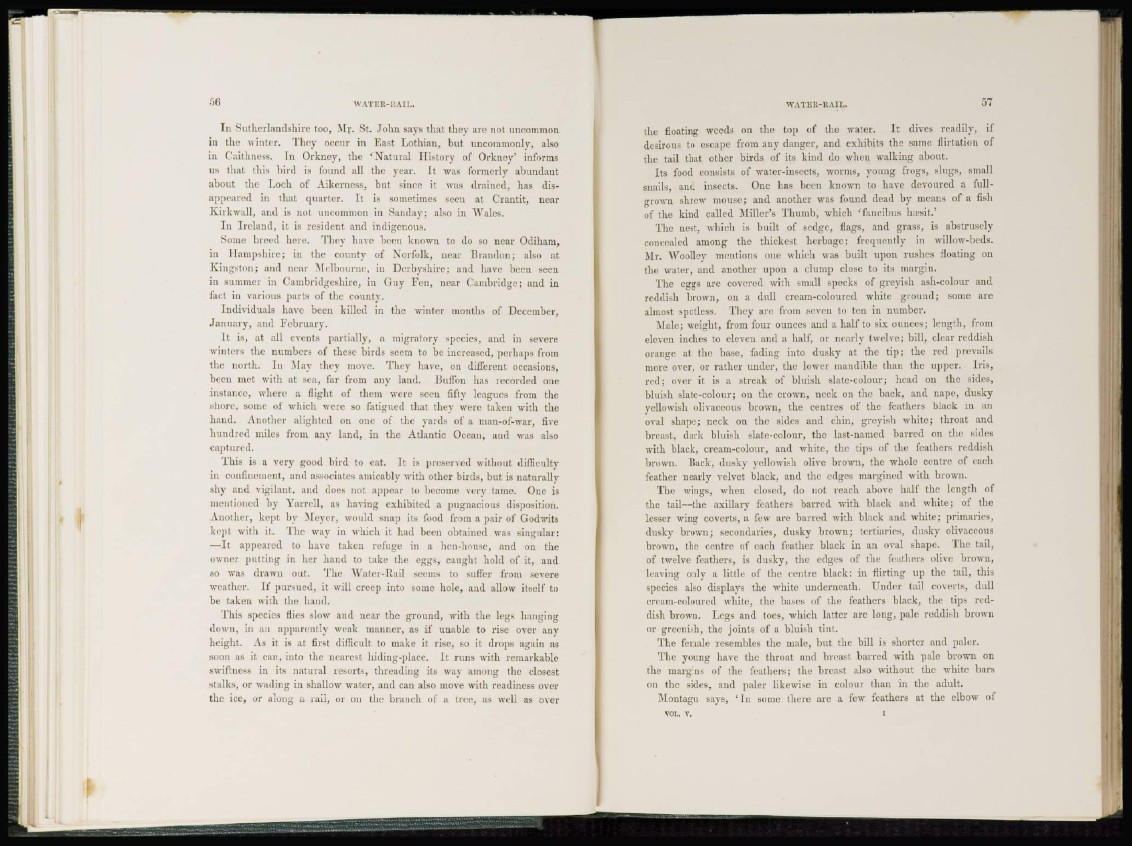
56 W A T E R - I t A IT,.
I n Sutherlandshirc too, Mr. St. John says that they are not uncommon
in the winter. They occur in East Lothian, but uncommonly, also
in Caithness. In Orkney, the ' Natural History of Orkney' informs
us that this bird is found all the year. It was formerly abundant
about the Loch of Aikerness, but since it was drained, has disappeared
in that quarter. It is sometimes seen at Crantit, near
Kirkwall, and is not uncommon in Sunday; also in Wales.
I n Ireland, it is resident and indigenous.
Some breed here. They have been known to do so near Odiham,
in Hampshire; in the county of Norfolk, near Brandon; also at
Kingston; and near Melbourne, in Derbyshire; and have been seen
in summer in Cambridgeshire, in Guy Fen, near Cambridge; and in
fact in various parts of the county.
Individuals have been killed in the winter months of December,
January, and February.
It is, at all events partially, a migratory species, and in severe
winters the numbers of these birds seem to be increased, perhaps from
the north. In May they move. They have, on different occasions,
been met with at sea, far from any land. Buffon has recorded one
instance, where a flight of them were seen fifty leagues from the
shore, some of which were so fatigued that they were taken with the
hand. Another alighted on one of the yards of a man-of-war, five
hundred miles from any land, in the Atlantic Ocean, and was also
captured.
This is a very good bird to eat. It is preserved without difficulty
in confinement, and associates amicably with other birds, but is naturally
shy and vigilant, and does not appear to become very tamo. One is
men! loned by Yarrell, as having exhibited a pugnacious disposition.
Another, kept by Meyer, would snap its food from a pair of Godwits
kept with it. The way in which it had been obtained was singular:
—It appeared to have taken refuge in a hen-house, and on the
owner putting in her hand to take the eggs, caught hold of it, and
so was drawn out. The Water-Hail seems to suffer from severe
weather. If pursued, it will creep into some hole, and allow itself to
be taken with the baud.
This species flies slow and near the ground, with the legs hanging
down, in an apparently weak manner, as if unable to rise over any
height. As it is at first difficult to make it rise, so it drops again as
soon as it can, into the nearest hiding-place. It runs with remarkable
swiftness in its natural resorts, threading its way among the closest
stalks, or wading in shallow water, and can also move with readiness over
the ice, or along a rail, or on the branch of a tree, as well as over
WATER-RAIL. 5 7
the floating weeds on the top of the water. It dives readily, if
desirous to escape from any danger, and exhibits the same flirtation of
the tail that other birds of its kind do when walking about.
I t s food consists of water-insects, worms, young frogs, slugs, small
snails, and insects. One has been known to have devoured a fullgrown
shrew mouse; and another was found dead by means of a fish
of the kind called Miller's Thumb, which 'faucibus haesit.'
The nest, winch is built of sedge, flags, and grass, is abstrusely
concealed among the thickest herbage; frequently in willow-beds.
Mr. Woolley mentions one which was built upon rushes floating on
the water, and another upon a clump close to its margin.
The eggs are covered with small specks of greyish ash-colour and
reddish brown, on a dull cream-coloured white ground; some are
almost spotless. They are from seven to ten in number.
Male; weight, from four ounces and a half to six ounces; length, from
eleven inches to eleven and a half, or nearly twelve; bill, clear reddish
orange at the base, fading into dusky at the t i p ; the red prevails
more over, or rather under, the lower mandible than the upper. Iris,
red; over it is a streak of bluish slate-colour; head on the sides,
bluish slate-colour; on the crown, neck on the back, and nape, dusky
yellowish olivaceous brown, the centres of the feathers black in an
oval shape; neck on the sides and chin, greyish white; throat and
breast, dark bluish slate-colour, the last-named barred on the sides
with black, cream-colour, and white, the tips of the feathers reddish
brown. Back, dusky yellowish olive brown, the whole centre of each
feather nearly velvet black, and the edges margined with brown.
The wings, when closed, do not reach above half the length of
the tail—the axillary feathers barred with black and white; of the
lesser wing coverts, a few are barred with black and white; primaries,
dusky brown; secondaries, dusky brown; tertiaries, dusky olivaceous
brown, the centre of each feather black in an oval shape. The tail,
of twelve feathers, is dusky, the edges of the feathers olive brown,
leaving only a little of the centre black: in flirting up the tail, this
species also displays the white underneath. Under tail coverts, dull
cream-coloured white, the bases of the feathers black, the tips reddish
brown. Legs and toes, which latter are long, pale reddish brown
or greenish, the joints of a bluish tint.
The female resembles the male, but the bill is shorter and paler.
The young have the throat and breast barred with pale brown on
the margins of the feathers; the breast also without the white bars
on the sides, and paler likewise in colour than in the adult.
Montagu says, ' I n some there are a few feathers at the elbow of
VOL. V. I